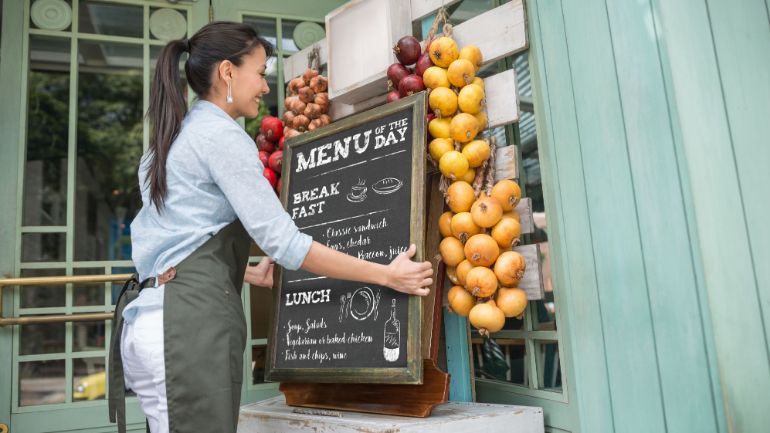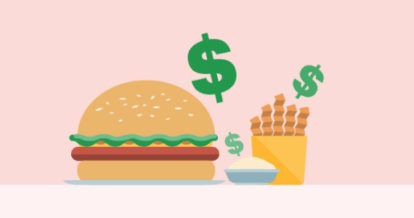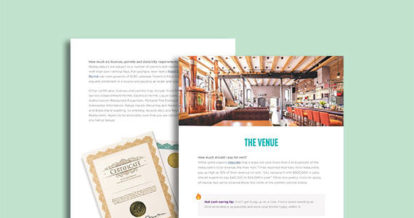Are you struggling to increase your restaurant’s average check size?
You already know what an average check size is: the average amount a customer spends at your restaurant.
You also know how to calculate it: divide total sales by the number of covers.
And because you understand that your restaurant check size is one of the most important metrics to track – it tells you how well you’re maximizing your sales – you may even have weekly meetings with your team about it. You check in with your servers and discuss different strategies to bump that restaurant check size higher and higher.
But despite your best efforts, you might be seeing little to no improvement from one week to the next.
You might be wondering, “What am I doing wrong? What strategies actually work?”
This post answers these questions by providing four complementary strategies you can use to increase your the average check size at your restaurant.
Ready? Let’s get started.
1. Build Your Staffs’ Menu Knowledge Through Training
Walk into any car dealership and you’ll notice that most salespeople will confidently recommend a car based on your needs.
How do they do it?
They know what they’re selling. They have an intricate knowledge of each vehicle so they can make recommendations based on your needs such as your budget, desire for comfort, and so on.
Selling cars is no different than selling food. Employees first need to understand their role and the food they’re selling. And this knowledge starts with training.
Training empowers employees to do their job correctly and helps instill confidence in the customer.
Just think about it. You’d probably feel more comfortable buying from someone who has product knowledge compared to someone who has no clue.
But how exactly do you build this knowledge?
You need to train servers so they know the menu inside out. But, their knowledge needs to go beyond knowing the menu items off by heart. You need to ensure that servers:
- Can provide detailed descriptions of all dishes – being able to build on the menu description will help entice diners to make a purchase.
- Can explain words on the menu that may be foreign to customers.
- Know which menu items complement one another, so they can make better recommendations.
- Can identify the most profitable items, so they can guide diners to purchase these items.
- Understand how each dish tastes, so they can speak from experience when selling (which leads to more detailed and colorful explanations that can drive purchases).
- Can point out daily specials that many customers won’t notice.
- Can explain the reason behind the special (e.g. it’s made of seasonal ingredients or offers better value).

Here are some training tips to build menu knowledge:
- Introduce regular taste tests in your restaurant, especially if your menu changes frequently. Allocate times and days specifically dedicated to tastings.
- Have a quiz night where you ask questions about the dishes and reward the first place team with a prize. By gamifying the training process, you improve staff engagement. Staff will want to learn and better remember what they’ve learned.
- Create roleplaying scenarios where you’re the customer asking for advice and recommendations. You can create various situations to test different skills such as their ability to recall specials, describe dishes, and suggest complementary sides.

2. Master the Cross-Sell and Upsell
Detailed menu knowledge will help staff cross-sell and upsell. But what exactly is the difference?
Cross-selling and upselling, though often used interchangeably, are notably different. Cross-selling is where you encourage customers to purchase complementary items. Upselling involves enticing customers to buy more expensive items, upgraded items, or add-ons to their current order.
This is best explained through a few examples.
If a server recommends pairing a specific pinot noir wine with a certain meal, they’re cross-selling. This could mean recommending a specific red wine, like Cabernet Sauvignon, with a steak or a white wine, like Chardonnay, with fish.
Now, if these servers were to encourage diners to increase the restaurant portion sizes (e.g. from an eight ounce steak to 10 ounces), opt for the higher-end option (e.g. a more expensive cut of meat), or choose some add-ons (e.g. a shrimp skewer for the steak or gravy for the fries), they would be upselling.
Of course, when cross-selling or upselling, servers should avoid being pushy for the sake of a sale. This will only leave a sour taste in diners’ mouths. You don’t want them thinking it’s all about the money.
The better approach is to make small, marginally better, recommendations based on diner’s needs and wants.
Context and timing is also everything. For example, if a dish is made to order, a server can inform the diner of the expected wait time and tactfully suggest a drink while they wait. It’s a win-win: Your customer will be happy, and your restaurant will benefit from an increase in check size.
Encourage Your Team to Upsell and Cross-sell
As good as cross-selling is on paper, executing this selling technique can be hard in practice. Training will help, but you’ll have to continually remind staff to do so because it’s easy to forget about cross-selling and upselling when work gets busy.
Unless…
You shape their behavior with rewards and incentives.
Reinforcement theory suggests you can achieve the desired behavior by either penalizing (negative reinforcement) or rewarding employees (positive reinforcement).
With positive reinforcement, individuals are more inclined to repeat specific behavior if they associate it with a positive outcome.
So, start offering your employees incentives to encourage cross and upselling. These incentives can be performance-based, where employees receive a commission based on hitting a defined sales quota (e.g. 12 bottles of wine sold per night). Or incentives can be as simple as an “Employee of the Month” award.
It’s important, though, to ensure that the incentives you create are achievable. If, for example, you set an almost unattainable sales target, the staff will quickly catch on and lose motivation. Who wants to work their butt off for a goal they’ll probably never realize?
And finally, while you can train and remind staff to upsell as well as offer incentives, sales can still slip through the cracks. That’s why it’s so important to make upselling and cross-selling an integral part of your entire customer service experience, across your menu design, and POS system.
3. Include More Menu Modifiers on Your POS
As you may know, menu modifiers are extra menu items that let diners customize their meal. Examples typically include offering extra sides and sauces, or coffee with dessert.
Setting up modifiers for each menu item within your POS acts as a constant reminder to servers to cross-sell and upsell instead of having to rely on verbal reminders – you can even set up automatic prompts. Your POS then provides support to your servers and helps automate the entire service experience.
While you probably already use several modifiers on your POS to encourage cross-selling and upselling, find ways to include even more. Review your menu, analyze your POS sales data, and consider which additional modifiers could help boost sales.
Here are more examples of modifiers you may want to add:
- Sparkling water instead of tap water
- Burgers by the ounce (4oz., 6oz., and 8oz.)
- Protein powders with smoothies
- Salads with a protein like beef or fish
4. Engineering Your Menu the Right Way
Your menu is more than just a list of dishes and drinks for customers to choose from. It’s a strategic tool you can use to increase revenue.
Here are several ways you can improve your menu design to increase average check size.
Include High-Margin Items in the Golden Triangle
When diners read a menu, their eyes typically go first to the center, then the top right, and then top left. This, the prime real estate area known as the Golden Triangle, is where you want to include your items that have high profit margins.
Call-Out High-Margin Items
While diners’ eyes naturally gravitate to the golden triangle, that’s not the only area you need to focus on. There are other tactics you can use to draw someone’s attention and influence ordering choices. Call-out specific menu items through bolding and italicizing. These call-outs will capture the customers’ attention and help guide purchases toward specials, add-ons, or upgrades that will really boost that restaurant check size.
Limit the Number of Menu Items
Have you ever felt so overwhelmed by options that you struggle to choose? You’re not alone.
The Paradox of Choice suggests that when faced with too many choices, we feel anxious and confused and are less likely to make a decision.
In the context of a restaurant, this means that large menus impede the diners’ decision-making process. And when diners do eventually choose, the chances are good they’ll select a familiar dish. Now, this isn’t necessarily a problem if the familiar dish is a profitable one. It becomes problematic when that dish is a low margin one, which impacts your restaurant’s average check size.
The better approach is to limit customer choice and reduce the number of items per menu category.
But what is the optimal number of items?
According to menu engineer Gregg Rapp, it’s seven. This means seven desserts, seven mains, and seven entrées.
Introduce Decoy Dishes
As the name suggests, these are dishes that act as a decoy to push diners away from specific items toward others.
For example, by placing a relatively more expensive dish in the Golden Triangle, you create the perception that other dishes are (relatively) cheaper and better value for money. And who doesn’t love getting a deal?
Feeling like they’ve landed a deal – a menu item that could be your most profitable dish – can even lead diners to order more.
Re-Engineer Your Menu for Cross-Selling
Finally, you can also engineer your menu for cross-selling by following this three-step process:
Step 1: Review current menu pairings. Analyze current POS data to see what items customers often purchase together (e.g. certain wines with specific dishes).
Step 2: Group these pairings. Group pairings in a spreadsheet and chose only those best suited for cross-selling (i.e. high margin items that will help boost your average order value). You may forego specific pairings that aren’t working.
Step 3: Call-out these items. Highlight these items on your menu to prompt diners to make a purchase. For example, include a recommended wine in bold just below the main dish.
You know you should increase your average restaurant check size to boost sales.
But deciding what strategies to use can be a big challenge. It doesn’t have to be – if you focus on the right mix of strategies that complement one another and support the entire customer service experience:
- Train staff so they have adequate menu knowledge
- Master the cross-sell and upsell without pushing the sale
- Add more menu modifiers on your POS and set up automatic prompts
- Improve your menu design by including high-margin items in the Golden Triangle, calling out profitable dishes, limiting menu items, introducing decoy dishes, and reengineering for cross-selling
Once you start implementing these strategies, be sure to track your restaurant check size and watch the average amount go up and up.

Learn how to make the most of your restaurant reports
Sign up for our free weekly TouchBistro Newsletter







